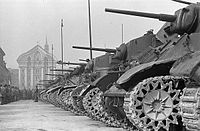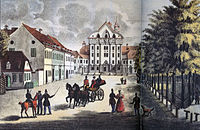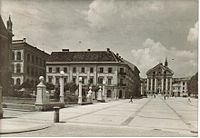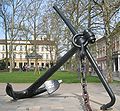- Congress Square
-
Congress Square (Slovene: Kongresni trg) is one of the central squares in Ljubljana, the capital of Slovenia.
The square was built in 1821 at the site of the ruins of a medieval Capuchin monastery, which had been abolished during the reign of Habsburg Emperor Joseph II. The square was used for ceremonial purposes during the Congress of Ljubljana, after which it was named. After the congress, a park was laid out in the center of the square, which soon acquired the name Star Park (Slovene: Park Zvezda) due to its layout. During the communist period it was renamed to Revolution Square and few years later to Liberation Square (Slovene: Trg osvoboditve), but the local population continued to use the old name. In 1990, it regained its original name.
 Proclamation of the State of Slovenes, Croats and Serbs on October 29th 1918
Proclamation of the State of Slovenes, Croats and Serbs on October 29th 1918
The square has had a highly symbolic role in modern Slovenian history. On October 29, 1918, independence from Austrian-Hungarian rule and the establishment of the State of Slovenes, Croats and Serbs was proclaimed during a mass demonstration on the square.
 Congress Square during the celebration of the liberation of Belgrade
Congress Square during the celebration of the liberation of Belgrade
In May 1945, the Yugoslav Communist leader Josip Broz Tito first visited Slovenia after World War II and held a speech on the balcony of the University of Ljubljana, which faces the square.
On June 22, 1988, the first free mass demonstration was held on the square demanding the release of four Slovene journalists imprisoned by the Yugoslav army. The demonstration marked the beginning of the Slovenian spring which culminated in the declaration of Slovenia's independence on June 25, 1991. Independence was first demanded in the May Declaration, written by the Slovenian democratic opposition and signed by numerous civil society movements; the declaration was first publicly read by the poet Tone Pavček in a demonstration on Congress Square on May 8, 1989. In 1999 Bill Clinton became the first U.S. president to visit Slovenia. On June 21, he publicly addressed the crowd gathered on Congress Square, quoting the opening verses of the Slovenian national anthem.[1][2]
Buildings and monuments
Several important buildings face the square. Among them, there is the early Baroque Ursuline Church of the Holy Trinity, the Kazina building, one of the few Neoclassical buildings remaining in Ljubljana after the earthquake of 1895, the Slovenian Philharmonic building, and the rectorate of the University of Ljubljana, formerly the seat of the Provincial Diet of the Duchy of Carniola. The prestigious Slovenska matica publishing house also has its seat on the square.
During the Austro-Hungarian period, a monument to the Austrian General Joseph Radetzky, who was married to a Carniolan noblewoman and lived in Ljubljana in the last years of his life, stood in the park on the square. The monument was removed in 1919 and placed in the National Museum.
In the late 1930s, the square was renovated by the prominent Slovene architect Jože Plečnik. New trees on the park were planted, most of which are still there today. In 1940, an equestrian statue of King Alexander I of Yugoslavia created by the architect Lojze Dolinar was erected in the middle of the square. In 1941, the statue was removed by the Fascist Italian occupation forces. In 1954, after the formal annexation of Zone B of the Free Territory of Trieste to Yugoslavia, an anchor of the Italian ocean liner SS Rex, sunk near Koper during World War II, was placed in the park to symbolize victory over Italian expansionism and the union of the Slovenian Littoral with the rest of Slovenia.
Several other monuments also stand on the square: Jože Plečnik's memorial to the women who protested against the political imprisonment of Slovene patriots during the Italian occupation of the Province of Ljubljana, a fountain with drinking water designed by the architect Boris Kobe, and a replica of a golden Roman monument found among the ruins of Emona. A Biedermeier bandstand from the 1830s also stands in the park.
In December 2004 the artist Matej Andraž Vogrinčič set up an "Enchanted Forest" in the square consisting of 1,000 potted fir trees. The trees were later donated to the Slovene Forestry Institute, which used them to reforest areas in the north-west of the country [3]
-
The anchor of the ocean liner SS Rex
-
The main building of the University of Ljubljana, formerly the Carniolan State Mansion
-
The Slovenska matica building
References
- ^ http://www.rtvslo.si/kultura/drugo/foto-zgodbe-ki-so-se-dogajale-na-kongresnem-trgu/260463
- ^ http://www.rtvslo.si/kultura/razstave/kongresni-trg-kjer-se-je-pisala-zgodovina-slovenije/253129
- ^ "Vogrincic Turns Ljubljana Park into Enchanted Forrest". UKom.gov. 2004-12-21. Archived from the original on 2008-02-29. http://web.archive.org/web/20080229130717/http://www.ukom.gov.si/eng/slovenia/publications/slovenia-news/1520/1532/. Retrieved 2008-03-19.
Ljubljana (city municipality) Quarter communities Landmarks Argentina Park · Butchers' Bridge · Cankar Hall · Central Market · Cekin Mansion (museum) · Congress Square · Čopova Street · Exhibition and Convention Centre · Grain Bridge · National Gallery · Ljubljana opera house · Ljubljana Stock Exchange · Ljubljana City Hall · National Museum · Ljubljanica · Ljubljana Zoo · Bežigrad Stadium · University Medical Centre · Maister Monument · Town Square · Nebotičnik · National Library · Presidential Palace · Prešeren Square · Republic Square · Cobblers' Bridge · Dragon Bridge · Triple Bridge · Ljubljanica Sluice Gate · Robba's fountain · Slovenian Parliament · Tivoli Park · Vodnik Square · Žale · Navje · Stožice Stadium · BTC CityPalaces and houses Churches and
places of worshipSt. Nicholas' Cathedral · St. Peter's Church · Franciscan Church · Ursuline Church of the Holy Trinity · St. James' Church, Ljubljana · St. Florian's Church · Ljubljana Mosque · Serbian Orthodox church of Sts. Cyril and MethodiusCulture Slovenian Philharmonic · Ljubljana Summer Festival · Ljubljana International Film Festival · The Naked Stage · Metelkova · Cankar Hall · Bežigrad Stadium · Stožice Stadium · Križanke · KiberpipaScience and
educationUniversity of Ljubljana · Slovenian Academy of Sciences and Arts · Anton Melik Geographical Institute · Jožef Stefan Institute · Ljubljana school of psychoanalysis · Slovenian Museum of Natural History · Archives of the Republic of SloveniaSports Ljubljana Marathon · NK Olimpija · HDD Olimpija · KK Union Olimpija · Stožice Sports Park: (Stožice Stadium · Arena Stožice) · Bežigrad Stadium · Hala TivoliPeople Transport and
infrastructureSettlements outside
the urban centreBesnica · Brezje pri Lipoglavu · Dolgo Brdo · Dvor · Češnjica · Črna vas · Gabrje pri Jančah · Janče · Javor · Lipe · Mali Lipoglav · Mali Vrh pri Prežganju · Malo Trebeljevo · Medno · Pance · Podgrad · Podlipoglav · Podmolnik · Prežganje · Ravno Brdo · Rašica · Repče · Sadinja vas · Selo pri Pancah · Spodnje Gameljne · Srednje Gameljne · Stanežiče · Šentpavel · Toško Čelo · Tuji Grm · Veliki Lipoglav · Veliko Trebeljevo · Vnajnarje · Volavlje · Zagradišče · Zgornja Besnica · Zgornje GameljneCoordinates: 46°03′01″N 14°30′13″E / 46.05028°N 14.50361°E
Categories:- Parks in Ljubljana
- Squares in Ljubljana
-
Wikimedia Foundation. 2010.














